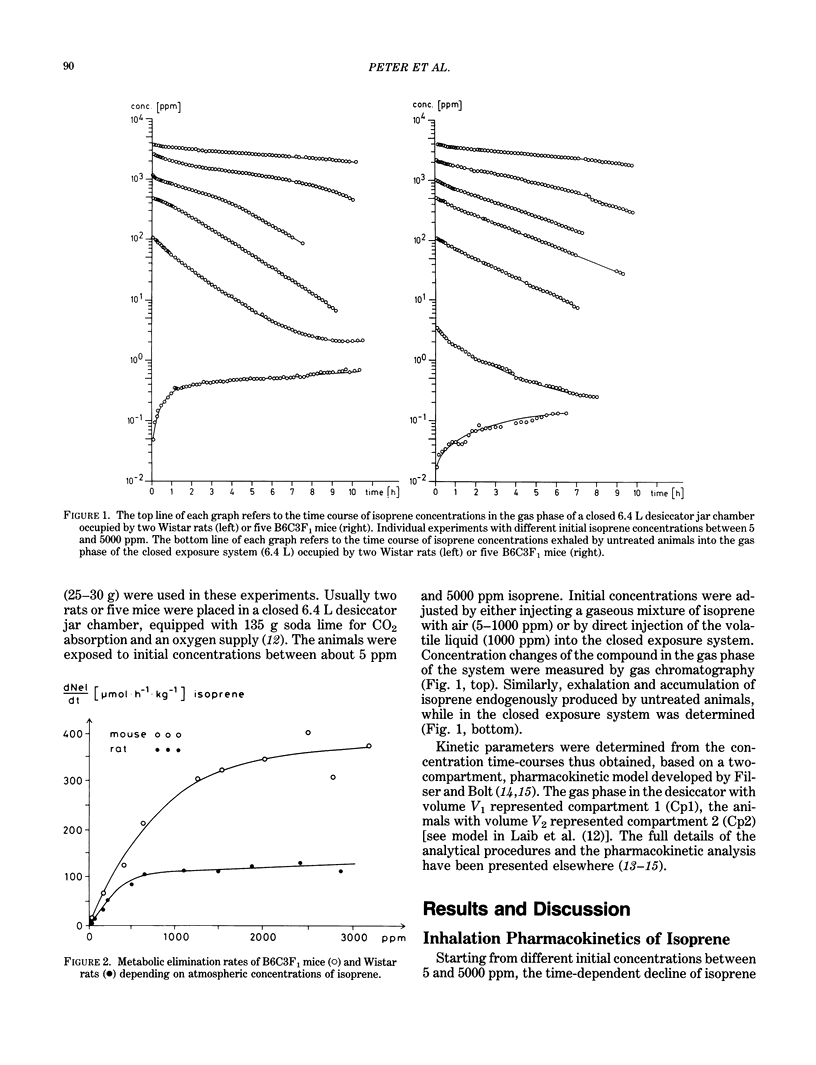Abstract
Studies on inhalation pharmacokinetics of isoprene were conducted in rats (Wistar) and mice (B6C3F1) to investigate possible species differences in metabolism of this compound. Pharmacokinetic analysis of isoprene inhaled by rats and mice revealed saturation kinetics of isoprene metabolism in both species. For rats and mice, linear pharmacokinetics apply at exposure concentrations below 300 ppm isoprene. Saturation of isoprene metabolism is practically complete at atmospheric concentrations of about 1000 ppm in rats and about 2000 ppm in mice. In the lower concentration range where first-order metabolism applies, metabolic clearance (related to the concentration in the atmosphere) of inhaled isoprene per kilogram body weight was 6200 mL/hr for rats and 12,000 mL/hr for mice. The estimated maximal metabolic elimination rates were 130 mumole/hr/kg for rats and 400 mumole/hr/kg for mice. This shows that the rate of isoprene metabolism in mice is about two or three times that in rats. When the untreated animals are kept in a closed all-glass exposure system, the exhalation of isoprene into the system can be measured. This shows that the isoprene endogenously produced by the animals is systemically available within the animal organism. From such experiments the endogenous production rate of isoprene was calculated to be 1.9 mumole/hr/kg for rats and 0.4 mumole/hr/kg for mice. Our data indicate that the endogenous production of isoprene should be accounted for when discussing a possible carcinogenic or mutagenic risk of this compound.
Full text
PDF



Selected References
These references are in PubMed. This may not be the complete list of references from this article.
- Dahl A. R., Birnbaum L. S., Bond J. A., Gervasi P. G., Henderson R. F. The fate of isoprene inhaled by rats: comparison to butadiene. Toxicol Appl Pharmacol. 1987 Jun 30;89(2):237–248. doi: 10.1016/0041-008x(87)90044-5. [DOI] [PubMed] [Google Scholar]
- Filser J. G., Bolt H. M. Inhalation pharmacokinetics based on gas uptake studies. I. Improvement of kinetic models. Arch Toxicol. 1981 Jul;47(4):279–292. doi: 10.1007/BF00332394. [DOI] [PubMed] [Google Scholar]
- Filser J. G., Bolt H. M. Inhalation pharmacokinetics based on gas uptake studies. IV. The endogenous production of volatile compounds. Arch Toxicol. 1983 Feb;52(2):123–133. doi: 10.1007/BF00354772. [DOI] [PubMed] [Google Scholar]
- Filser J. G., Bolt H. M. Inhalation pharmacokinetics based on gas uptake studies. VI. Comparative evaluation of ethylene oxide and butadiene monoxide as exhaled reactive metabolites of ethylene and 1,3-butadiene in rats. Arch Toxicol. 1984 Oct;55(4):219–223. doi: 10.1007/BF00341014. [DOI] [PubMed] [Google Scholar]
- Filser J. G., Bolt H. M., Muliawan H., Kappus H. Quantitative evaluation of ethane and n-pentane as indicators of lipid peroxidation in vivo. Arch Toxicol. 1983 Feb;52(2):135–147. doi: 10.1007/BF00354773. [DOI] [PubMed] [Google Scholar]
- Gelmont D., Stein R. A., Mead J. F. Isoprene-the main hydrocarbon in human breath. Biochem Biophys Res Commun. 1981 Apr 30;99(4):1456–1460. doi: 10.1016/0006-291x(81)90782-8. [DOI] [PubMed] [Google Scholar]
- Gervasi P. G., Citti L., Del Monte M., Longo V., Benetti D. Mutagenicity and chemical reactivity of epoxidic intermediates of the isoprene metabolism and other structurally related compounds. Mutat Res. 1985 Apr-May;156(1-2):77–82. doi: 10.1016/0165-1218(85)90009-6. [DOI] [PubMed] [Google Scholar]
- Gervasi P. G., Longo V. Metabolism and mutagenicity of isoprene. Environ Health Perspect. 1990 Jun;86:85–87. doi: 10.1289/ehp.908685. [DOI] [PMC free article] [PubMed] [Google Scholar]
- Huff J. E., Melnick R. L., Solleveld H. A., Haseman J. K., Powers M., Miller R. A. Multiple organ carcinogenicity of 1,3-butadiene in B6C3F1 mice after 60 weeks of inhalation exposure. Science. 1985 Feb 1;227(4686):548–549. doi: 10.1126/science.3966163. [DOI] [PubMed] [Google Scholar]
- Jones A. W. Excretion of low-molecular weight volatile substances in human breath: focus on endogenous ethanol. J Anal Toxicol. 1985 Nov-Dec;9(6):246–250. doi: 10.1093/jat/9.6.246. [DOI] [PubMed] [Google Scholar]
- Laib R. J., Filser J. G., Kreiling R., Vangala R. R., Bolt H. M. Inhalation pharmacokinetics of 1,3-butadiene and 1,2-epoxybutene-3 in rats and mice. Environ Health Perspect. 1990 Jun;86:57–63. doi: 10.1289/ehp.908657. [DOI] [PMC free article] [PubMed] [Google Scholar]
- Longo V., Citti L., Gervasi P. G. Hepatic microsomal metabolism of isoprene in various rodents. Toxicol Lett. 1985 Dec;29(1):33–37. doi: 10.1016/0378-4274(85)90196-1. [DOI] [PubMed] [Google Scholar]
- Melnick R. L., Roycroft J. H., Chou B. J., Ragan H. A., Miller R. A. Inhalation toxicology of isoprene in F344 rats and B6C3F1 mice following two-week exposures. Environ Health Perspect. 1990 Jun;86:93–98. doi: 10.1289/ehp.908693. [DOI] [PMC free article] [PubMed] [Google Scholar]
- Peter H., Wiegand H. J., Bolt H. M., Greim H., Walter G., Berg M., Filser J. G. Pharmacokinetics of isoprene in mice and rats. Toxicol Lett. 1987 Mar;36(1):9–14. doi: 10.1016/0378-4274(87)90035-x. [DOI] [PubMed] [Google Scholar]
- Shelby M. D. Results of NTP-sponsored mouse cytogenetic studies on 1,3-butadiene, isoprene, and chloroprene. Environ Health Perspect. 1990 Jun;86:71–73. doi: 10.1289/ehp.908671. [DOI] [PMC free article] [PubMed] [Google Scholar]
- Tice R. R., Boucher R., Luke C. A., Paquette D. E., Melnick R. L., Shelby M. D. Chloroprene and isoprene: cytogenetic studies in mice. Mutagenesis. 1988 Mar;3(2):141–146. doi: 10.1093/mutage/3.2.141. [DOI] [PubMed] [Google Scholar]
- Tice R. R., Boucher R., Luke C. A., Shelby M. D. Comparative cytogenetic analysis of bone marrow damage induced in male B6C3F1 mice by multiple exposures to gaseous 1,3-butadiene. Environ Mutagen. 1987;9(3):235–250. doi: 10.1002/em.2860090303. [DOI] [PubMed] [Google Scholar]


